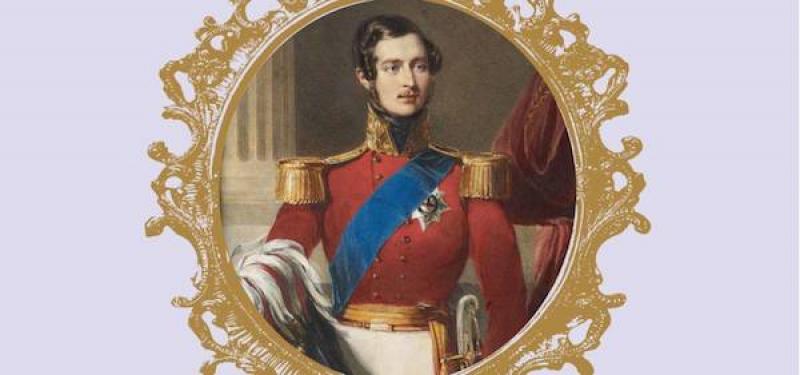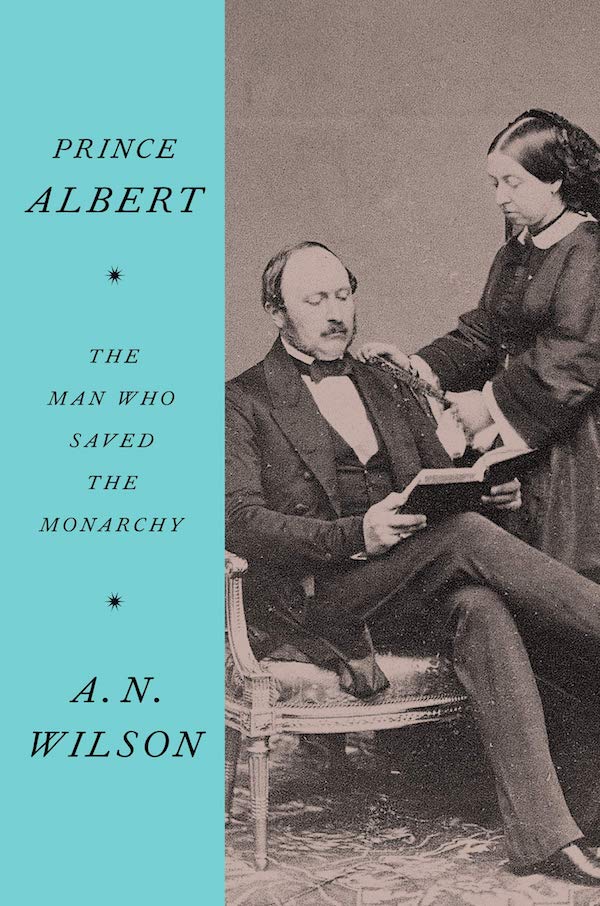A N Wilson: Prince Albert review - entertaining bio is a total treat | reviews, news & interviews
A. N. Wilson: Prince Albert review - entertaining bio is a total treat
A. N. Wilson: Prince Albert review - entertaining bio is a total treat
Engrossing and lively volume reveals 'the power behind the throne'

Albertopolis! The Royal Albert Hall, the Albert Memorial and countless Albert Squares, Roads and Streets all commemorate Britain’s uncrowned king. In this mesmerising biography, novelist and historian A. N. Wilson’s admiration and affection for Prince Albert – who spent 22 years as Victoria’s husband – make for an irresistible and informative read.
The pace is akin to a novel – brisk and confident – and builds Wilson’s substantial volume on Victoria (2014). Wilson is sometimes criticised for his remarkable ability to popularise the complex. But he has examined a vast array of original sources: from the Royal archives at Windsor, those of the 1851 Great Exhibition at Imperial College, as well as half-a-dozen state and royal archives in Germany, and a wealth of secondary sources.
The book calls attention to the royal couple’s bicentenary. Victoria, daughter of the Duke of Kent and a minor German princess, was born 200 years ago and became Queen principally due to the vagaries of heredity and uncertain breeding activities of the British royal family. A few months later, her first cousin Albert was born – a minor German princeling who became Britain’s uncrowned king and, as many think, the power behind the throne. Although touched by scandal (his father was a dissolute divorcee), he joined a small pool of German aristocrats from whom the future royal consort was to be chosen. Victoria was attracted to him from the first and accounts suggest it was a union of mutual and profound attachment.
The couple married in 1840, both aged only 20. Their public image of connubial bliss was criticised by grandees as being too bourgeois. Modern historians point out this is far from the truth.
Victoria was a mother of nine and became mother-in-law and grandmother to almost all the significant European royal families. She was passionate and often bad tempered, worn out and irritable from almost interminable child-bearing. Writing was her therapy. Despite the burning of significant correspondence by Princess Beatrice, it has been estimated that if all her journals and letters were published they would take up around 700 volumes. Albert’s quick intelligence was maddened by what he saw as Victoria’s prejudices. He was happiest in discussions with his male contemporaries and often reproached Victoria for her tantrums. Sometimes he responded with fury. Yet Albert was affectionate towards Victoria and their children, and was deeply saddened by the death of his pet greyhound, Eos.
Wilson incorporates the latest perspectives on Albert’s untimely death at 42. He had gone to Cambridge remonstrate with his feckless heir, Bertie, who was (scandalously) in love with an actress. The commonly-held belief was that typhoid from bad drains did for him, but several years of failing health suggests it might have been stomach cancer. While he was incredibly energetic, we are reminded Albert aged early: in his mid 20s he was already bald, possibly wearing a wig, and had grown a paunch.
 Wilson makes a convincing case for Albert having modernised the monarchy in two ways: teasing Victoria away from overt political preferences between the scrapping Whigs and Tories, and laying the foundation for the (non-written) constitutional monarchy which has survived to this day. And what an empire on which to make his mark – yet throughout his short life he was homesick for Germany.
Wilson makes a convincing case for Albert having modernised the monarchy in two ways: teasing Victoria away from overt political preferences between the scrapping Whigs and Tories, and laying the foundation for the (non-written) constitutional monarchy which has survived to this day. And what an empire on which to make his mark – yet throughout his short life he was homesick for Germany.
In many respects, Albert’s role was subversive. He was subject to not-so-subtle anti-German sentiment and only officially made Prince Consort in 1857. For his day he was unusually well-educated and progressive. He actively supported the abolition of slavery and repealing the Corn Laws; he supported attempts to mitigate the abuses of child labour and was in favour of free trade. As Chancellor of the University of Cambridge, he was influential in broadening the university’s curricula beyond the classics, into science, modern languages and history.
He and Victoria were ardent musicians who composed music; both were photography obsessives. Notably Albert pioneered photography as a tool to help spread education (for instance to reproduce great paintings) and included in the book are some compelling photographs of Albert himself. He was a committed art historian and catalogued the works of Raphael which he made widely available through prints and photography. He collected art and designed jewellery: the charming sapphire and diamond tiara he designed for his queen has just entered the collections of the V&A. They were the last royals to have a substantial influence on high culture.
Albert was certainly an extraordinary force, whose legacy – from Albertopolis to the model farms of Windsor and the lasting influence of the Victorian era on British society and politics – persists to this day. He faced understandable difficulties working out his unique role as (in his own phrase) only the husband, not the master in the house. And with two centuries’ hindsight, his ambivalence regarding traditionally gendered roles now look remarkably modern.
The Royal Collection has just published more than 17,500 photographs, prints, private and official papers online – many made public for the first time. Albert’s great ambition for a European union built on Victoria’s dynasty lies in ruins, sabotaged by the bloody horrors of the last century. But much of what he desired remains relevant today. A. N. Wilson’s brilliant book is a treat: an accessible, absorbing and entertaining guide to the complex tensions and contradictions of Albert’s world. And somehow, he convinces us the monarchy was worth saving.
- Prince Albert: The Man Who Saved the Monarchy by A. N. Wilson (Atlantic £25)
- Read more book reviews on theartsdesk
The future of Arts Journalism
You can stop theartsdesk.com closing!
We urgently need financing to survive. Our fundraising drive has thus far raised £49,000 but we need to reach £100,000 or we will be forced to close. Please contribute here: https://gofund.me/c3f6033d
And if you can forward this information to anyone who might assist, we’d be grateful.

Subscribe to theartsdesk.com
Thank you for continuing to read our work on theartsdesk.com. For unlimited access to every article in its entirety, including our archive of more than 15,000 pieces, we're asking for £5 per month or £40 per year. We feel it's a very good deal, and hope you do too.
To take a subscription now simply click here.
And if you're looking for that extra gift for a friend or family member, why not treat them to a theartsdesk.com gift subscription?
more Books
 'We are bowled over!' Thank you for your messages of love and support
Much-appreciated words of commendation from readers and the cultural community
'We are bowled over!' Thank you for your messages of love and support
Much-appreciated words of commendation from readers and the cultural community
 Justin Lewis: Into the Groove review - fun and fact-filled trip through Eighties pop
Month by month journey through a decade gives insights into ordinary people’s lives
Justin Lewis: Into the Groove review - fun and fact-filled trip through Eighties pop
Month by month journey through a decade gives insights into ordinary people’s lives
 Joanna Pocock: Greyhound review - on the road again
A writer retraces her steps to furrow a deeper path through modern America
Joanna Pocock: Greyhound review - on the road again
A writer retraces her steps to furrow a deeper path through modern America
 Mark Hussey: Mrs Dalloway - Biography of a Novel review - echoes across crises
On the centenary of the work's publication an insightful book shows its prescience
Mark Hussey: Mrs Dalloway - Biography of a Novel review - echoes across crises
On the centenary of the work's publication an insightful book shows its prescience
 Frances Wilson: Electric Spark - The Enigma of Muriel Spark review - the matter of fact
Frances Wilson employs her full artistic power to keep pace with Spark’s fantastic and fugitive life
Frances Wilson: Electric Spark - The Enigma of Muriel Spark review - the matter of fact
Frances Wilson employs her full artistic power to keep pace with Spark’s fantastic and fugitive life
 Elizabeth Alker: Everything We Do is Music review - Prokofiev goes pop
A compelling journey into a surprising musical kinship
Elizabeth Alker: Everything We Do is Music review - Prokofiev goes pop
A compelling journey into a surprising musical kinship
 Natalia Ginzburg: The City and the House review - a dying art
Dick Davis renders this analogue love-letter in polyphonic English
Natalia Ginzburg: The City and the House review - a dying art
Dick Davis renders this analogue love-letter in polyphonic English
 Tom Raworth: Cancer review - truthfulness
A 'lost' book reconfirms Raworth’s legacy as one of the great lyric poets
Tom Raworth: Cancer review - truthfulness
A 'lost' book reconfirms Raworth’s legacy as one of the great lyric poets
 Ian Leslie: John and Paul - A Love Story in Songs review - help!
Ian Leslie loses himself in amateur psychology, and fatally misreads The Beatles
Ian Leslie: John and Paul - A Love Story in Songs review - help!
Ian Leslie loses himself in amateur psychology, and fatally misreads The Beatles
 Samuel Arbesman: The Magic of Code review - the spark ages
A wide-eyed take on our digital world can’t quite dispel the dangers
Samuel Arbesman: The Magic of Code review - the spark ages
A wide-eyed take on our digital world can’t quite dispel the dangers
 Zsuzsanna Gahse: Mountainish review - seeking refuge
Notes on danger and dialogue in the shadow of the Swiss Alps
Zsuzsanna Gahse: Mountainish review - seeking refuge
Notes on danger and dialogue in the shadow of the Swiss Alps
 Patrick McGilligan: Woody Allen - A Travesty of a Mockery of a Sham review - New York stories
Fair-minded Woody Allen biography covers all bases
Patrick McGilligan: Woody Allen - A Travesty of a Mockery of a Sham review - New York stories
Fair-minded Woody Allen biography covers all bases

Add comment